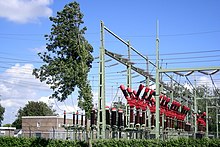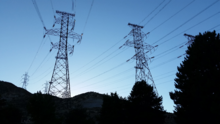Electric power industry

The electric power industry covers the
By the middle of the 20th century, electricity was seen as a "natural monopoly", only efficient if a restricted number of organizations participated in the market; in some areas, vertically-integrated companies provide all stages from generation to retail, and only governmental supervision regulated the rate of return and cost structure.
Since the 1990s, many regions have broken up the generation and distribution of electric power[citation needed]. While such markets can be abusively manipulated with consequent adverse price and reliability impact to consumers, generally competitive production of electrical energy leads to worthwhile improvements in efficiency[citation needed]. However, transmission and distribution are harder problems since returns on investment are not as easy to find.
History


Although electricity had been known to be produced as a result of the chemical reactions that take place in an electrolytic cell since Alessandro Volta developed the voltaic pile in 1800, its production by this means was, and still is, expensive. In 1831, Michael Faraday devised a machine that generated electricity from rotary motion, but it took almost 50 years for the technology to reach a commercially viable stage. In 1878, in the United States, Thomas Edison developed and sold a commercially viable replacement for gas lighting and heating using locally generated and distributed direct current electricity.
Robert Hammond, in December 1881, demonstrated the new electric light in the Sussex town of Brighton in the UK for a trial period. The ensuing success of this installation enabled Hammond to put this venture on both a commercial and legal footing, as a number of shop owners wanted to use the new electric light. Thus the Hammond Electricity Supply Co. was launched.
In early 1882, Edison opened the world's first steam-powered electricity generating station at
It was later on in the year in September 1882 that Edison opened the
The mid to late 1880s saw the introduction of

The AC power system used today developed rapidly, backed by industrialists such as George Westinghouse with Mikhail Dolivo-Dobrovolsky, Galileo Ferraris, Sebastian Ziani de Ferranti, Lucien Gaulard, John Dixon Gibbs, Carl Wilhelm Siemens, William Stanley Jr., Nikola Tesla, and others contributed to this field.
A breakthrough in power electronics came with the invention of the
While HVDC is increasingly being used to transmit large quantities of electricity over long distances or to connect adjacent asynchronous power systems, the bulk of electricity generation, transmission, distribution and retailing takes place using alternating current.
Organization

The electric power industry is commonly split up into four processes. These are
The nature and state of market reform of the
Generation
2021
Generation is the conversion of some primary energy source into electric power suitable for commercial use on an electrical grid. Most commercial electric power is produced by rotating electrical machines, "generators", which move conductors through a magnetic field to produce electric current. The generator is rotated by some other prime mover machine; in typical grid-connected generators this is a steam turbine, a gas turbine, or a hydraulic turbine. Primary energy sources for these machine are often fossil fuels (coal, oil, natural gas), nuclear fission, geothermal steam, or falling water. Renewable sources such as wind and solar energy are increasingly of commercial importance.
Since electrical generation must be closely matched with electrical consumption, enough generation capacity must be installed to meet peak demands. At the same time, primary energy sources must be selected to minimize the cost of produced electrical energy. Generally the lowest-incremental-cost source of electrical energy will be the next unit connected to meet rising demand. Electrical generators have automatic controls to regulate the power fed into the electrical transmission system, adjusting generator output moment by moment to balance with electrical demand. For a large grid with scores or hundreds of generators connected and thousands of loads, management of stable generator supply is a problem with significant challenges, to meet economic, environmental and reliability requirements. For example, low-incremental-cost generation sources such as nuclear power plants may be run continually to meet the average "base load" of the connected system, whereas more costly peaking power plants such as natural gas turbines may be run for brief times during the day to meet peak loads. Alternatively, load management strategies may encourage more even demand for electrical power and reduce costly peaks. Designated generator units for a particular electrical grid may be run at partial output only, to provide "spinning reserve" for sudden increases in demand or faults with other generating units.
In addition to electrical power production, electrical generation units may provide other ancillary services to the electrical grid, such as frequency control, reactive power, and black start of a collapsed power grid. These ancillary services may be commercially valuable when the generation, transmission, and distribution electrical companies are separate commercial entities.
Electric power transmission

Electric power transmission is the bulk movement of
A
Historically, transmission and distribution lines were owned by the same company, but starting in the 1990s, many countries have
Electric power distribution

Electric power distribution is the final stage in the
Electric retailing
Electricity retailing is the final sale of electricity from generation to the end-use consumer.
World electricity industries
The organization of the electrical sector of a country or region varies depending on the economic system of the country. In some places, all electric power generation, transmission and distribution is provided by a government controlled organization. Other regions have private or investor-owned utility companies, city or municipally owned companies, cooperative companies owned by their own customers, or combinations. Generation, transmission and distribution may be offered by a single company, or different organizations may provide each of these portions of the system.
Not everyone has access to grid electricity. About 840 million people (mostly in Africa) had no access in 2017, down from 1.2 billion in 2010.[14]
Market reform
The business model behind the electric utility has changed over the years playing a vital role in shaping the electricity industry into what it is today; from generation, transmission, distribution, to the final local retailing. This has occurred prominently since the reform of the electricity supply industry in England and Wales in 1990.
United States
In 1996 – 1999 the Federal Energy Regulatory Commission (FERC) made a series of decisions which were intended to open the U.S. wholesale power market to new players, with the hope that spurring competition would save consumers $4 to $5 billion per year and encourage technical innovation in the industry. [15] Steps were taken to give all market participants open access to existing interstate transmission lines.
- Order No. 888 ordered vertically integrated electric utilities to functionally separate their transmission, power generation and marketing businesses to prevent self-dealing.[16]
- Order No. 889 set up a system to provide all participants with timely access to information about available transmission capacity and prices.[17]
- The FERC also endorsed the concept of appointing independent system operators (ISOs) to manage the electric power grid – a function that was traditionally the responsibility of vertically integrated electric utility companies.[18] The concept of an independent system operator evolved into that of regional transmission organizations (RTOs). FERC's intention was that all U.S. companies owning interstate electric transmission lines would place those facilities under the control of an RTO.[19] In its Order No. 2000 (Regional Transmission Organizations), issued in 1999, FERC specified the minimum capabilities that an RTO should possess.[20]
These decisions, which were intended to create a fully interconnected grid and an integrated national power market, resulted in the restructuring of the U.S. electricity industry. That process was soon dealt two setbacks: the
Other countries
In some countries, wholesale electricity markets operate, with
Outlook
Electricity is expected to see growing
See also
- AC power
- Distributed generation
- Emissions & Generation Resource Integrated Database
- Meter Point Administration Number, a unique UK supply number
- National Grid (disambiguation)
- North American Electric Reliability Corporation
- Rate Case
- Reddy Kilowatt, a U.S. electricity corporate logo
- Samuel Insull
References
- ^ a b Shock and Awe: The Story of Electricity – 2. The Age of Invention
- ^ Thompson, M.T. "Notes 01" (PDF). Introduction to Power Electronics. Thompson Consulting, Inc.
- ^ Kharagpur. "Power Semiconductor Devices" (PDF). EE IIT. Archived (PDF) from the original on 20 September 2008. Retrieved 25 March 2012.
- Electronic Design. 21 April 2017. Retrieved 23 July 2019.
- ISBN 9780824780500.
- ^ "Advances in Discrete Semiconductors March On". Power Electronics Technology. Informa: 52–6. September 2005. Archived (PDF) from the original on 22 March 2006. Retrieved 31 July 2019.
- ^ a b "Power MOSFET Basics" (PDF). Alpha & Omega Semiconductor. Retrieved 29 July 2019.
- ^ ISBN 9780080508047.
- ^ "The Bumpy Road to Energy Deregulation". EnPowered. 2016-03-28. Archived from the original on 2017-04-07. Retrieved 2017-05-01.
- ^ "Yearly electricity data". ember-climate.org. 6 Dec 2023. Retrieved 23 Dec 2023.
- ^ "A Primer on Electric Utilities, Deregulation, and Restructuring of U.S. Electricity Markets" (PDF). United States Department of Energy Federal Energy Management Program (FEMP). May 2002. Retrieved October 30, 2018.
{{cite journal}}: Cite journal requires|journal=(help) - ISBN 978-1-4665-9865-2.
- ^ "How Power Grids Work". HowStuffWorks. Retrieved 2016-03-18.
- ^ Closing Sub-Saharan Africa’s Electricity Access Gap: Why Cities Must Be Part of the Solution
- ISBN 9780314150585.)
{{cite book}}: CS1 maint: multiple names: authors list (link - ^ Tomain and Cudahy op cit. pp. 276–277.
- ^ Tomain and Cudahy op cit. p. 277.
- ISBN 9780314150585.)
{{cite book}}: CS1 maint: multiple names: authors list (link - ^ "Order No. 2000" (PDF). Federal Energy Regulatory Commission. Retrieved 7 June 2021.
- ^ "U.S. Energy Law: Electricity (About Regional Transmission Organizations)". George Washington University Law Library.
- ^ Tomain and Cudahy op cit. pp. 285–297.
- ^ SEC filing dated March 15, 2000
- ^ "Electricity companies in the United Kingdom – a brief chronology," Electricity Association, 30 June 2003
- ^ a b Borberly, A. and Kreider, J. F. (2001). Distributed Generation: The Power Paradigm for the New Millennium. CRC Press, Boca Raton, FL. 400 pp.
Further reading
- P. Strange, "Early Electricity Supply in Britain: Chesterfield and Godalming", IEEE Proceedings (1979).
- D. G. Tucker, "Hydro-Electricity for Public Supply in Britain", Industrial Archaeology Review, (1977).
- B. Bowers, A History of Electric Light & Power, Peregrinus (1982).
- T. P. Hughes, Networks of Power, Johns Hopkins Press London (1983).
- , (2019).

